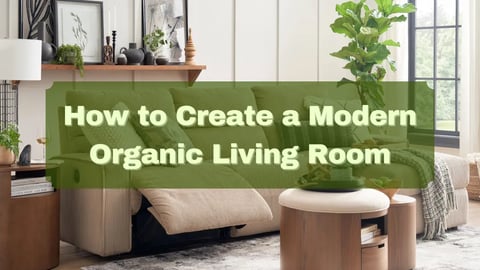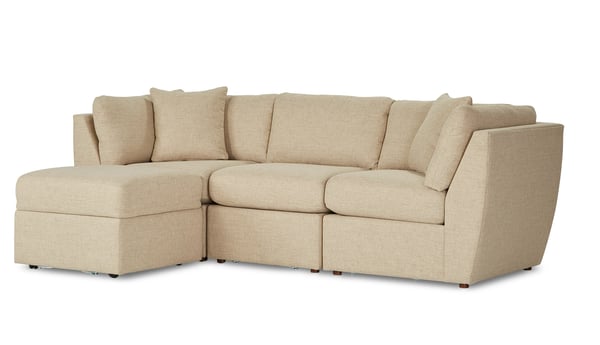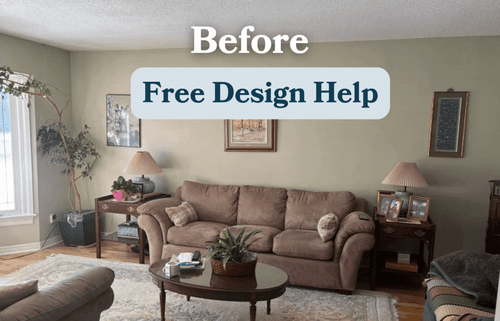How to Create a Modern Organic Living Room: Tips by an Expert
June 5, 2024

Est. Reading Time: 10 Mins
Since the beginning of the decade, we have seen quite drastic changes in how people decorate and furnish their homes. From modern vintage furniture to dark and moody colours, 2024’s design trends have been outside the box.
But, there is one latest emerging trend we have noticed that’s picking up a lot of steam; one that you might recognize, but has a different name to it.
Modern organic living rooms may look like biophilic designs, however, they are much different from that. In fact, Michelle MacLellan, our interior designer at La-Z-Boy Hunt Club, tells us that it is a completely different way of furnishing your home.
“Sure it has plants and greenery incorporated within the design, but there is a lot else going on here than just that,” she says.
So, what else does this design trend have that makes it stand out from others, and how can you make this design trend happen in your living room? This article will answer all of these questions, as well as show you some furniture pieces from La-Z-Boy that could go well in this type of living room.
In This Article…
- What Is a Modern Organic Living Room?
- How to Create a Modern Organic Room
- Examples of Modern Organic Furniture at La-Z-Boy
What Is a Modern Organic Living Room?
Modern organic living blends modern design with natural elements to create a relaxed lifestyle. Though these styles might seem different, they share a common goal: promoting relaxation.
“This is why these two styles work so well together,” La-Z-Boy interior designer Michelle says, “Because they have the same relaxed and casual core ideas instilled within them.”
Michelle also notes that the modern organic style tends to be softer than the traditional modern aesthetic many are accustomed to.
What she means by this is instead of choosing pure neutral colours, like a clear white, clients would go for an off-white colour like beige–something imperfect that isn’t so pristine and untouchable
And of course, natural elements play a huge factor in this design as well. So, instead of choosing a glass coffee table, a wooden coffee table might be preferred in this type of living room.
To learn more about Glass vs Wooden Coffee Tables, take a look at this article.

How to Create a Modern Organic Living Room
Now that you’re a little bit more familiar with the Modern Organic style, what are some things you should do to help reinforce this style? Here are a few tips and tricks when putting together a modern organic interior.
1. Keep the Colours Neutral
One of the most important things to keep in mind is to keep things simple. Dramatic and dynamic colours are not welcome in this type of living room. The reason why is that these kinds of rooms are meant to provoke a certain emotion–one that may not be relaxed.
The main thing to keep that relaxed feeling in a room is neutral colours since they take our attention away from dramatic feelings and help us feel calm.
Michelle also notes that warm greys are a popular colour to add to a modern organic interior. “I see lots of clients ask for greys with either brown or orange undertones,” she says
Warm undertones in colours can be a great way to visually trick guests into thinking more natural sunlight is coming into the room when it isn't.

2. Incorporate Natural Elements
A big factor to consider when creating a modern organic living room is the natural elements. After all, you can’t have a modern organic interior without organic elements.
As mentioned before, this does not just include plants and greenery. Sure, you can add these to your living room if you want to, but natural elements also include materials like linen, cotton, wood, jute, or wool.
With this in mind, Michelle notes that pieces like a wooden coffee table or jute baskets for storage would be great to add to these spaces. “It’s important to remember that everything in a room is planned and shouldn’t feel cluttered,” she says
So, try not to add too many natural elements either, since you may find yourself in a jungle rather than sitting in a living room!

3. Use Your Windows Like Never Before
 When it comes to adding natural elements to a room, it isn’t just decor or furniture pieces that come into play–it's also lighting!
When it comes to adding natural elements to a room, it isn’t just decor or furniture pieces that come into play–it's also lighting!
Natural light has always been around since the beginning of time. So, why not appreciate this natural element while indoors too?
Not only can you keep your windows open more often, but you could also add a mirror to your living room to help bounce light from one side to the other, allowing the space to feel more open than before.
Michelle says that you should not only use your windows as a funnel for natural lighting but it can also be used as an art piece too. “If you cannot cover your windows, the outside view can become a piece of art within itself,” she says
This type of mindset can work exceptionally well if you’re someone who wants to show off the scenery around them. Perhaps you live close to a forest and want to showcase that part of the area. Or you just have a really beautiful garden that you work hard on and want your guests to appreciate even more.
Whatever the case may be, a window can be used for much more than just letting light in.
To learn more about How to Brighten a Dark Living Room, take a look at this article.
4. Choose Asymmetrical Pieces
 Normally when designers refer to modern style, they talk about fixed pieces that are straight-edged and linear. However, when combining modern with organic elements, that straight line starts to curve.
Normally when designers refer to modern style, they talk about fixed pieces that are straight-edged and linear. However, when combining modern with organic elements, that straight line starts to curve.
This is quite literal with furniture pieces and decor in modern organic design. When looking at a modern organic living room, you’ll notice that a lot of furniture pieces, such as sofas and chairs, are not something you would typically see in a modern living room.
Instead, they are more curved and feel less put together in a sense. This does not mean they are less put together than a sofa or chair that's linear, it just means it is visually more relaxing to look at.
“Nothing is perfect in nature, so bringing things that look handmade can help enforce the style,” Michelle adds.
When it comes to decor pieces, though, you start to see that natural elements like clay and distressed wood come into play. Pieces that have knicks or asymmetrical patterns. Lamps that look like melted glass. These types of furniture decor pieces are favoured in a modern organic living room
Michelle also says that adding cobblestone patterns to a fireplace or anywhere else is also a great way to add an asymmetrical piece.
5. Think About Unique Lighting & Wall Art
Last but not least, decor pieces are essential in bringing this design style to life. However, Michelle notes that important places to add distinct attention to are your wall and your living room lighting
Modern organic is known to promote landscape wall art and unique overhang light fixtures to create a more concise room and to add the cherry on top of the modern organic style.
So, if you’re planning to go all out in your modern organic living room, think about adding wall art and some interesting statement lighting pieces to your room.
It is important, however, to add wall art pieces that only incorporate neutral colours, that way they do not disrupt the overall balance of the space.
To learn more about living room lighting, take a look at our article on How to Add Lighting to Your Living Room Using Table Lamps.

Examples of Modern Organic Furniture at La-Z-Boy
Now that we’ve shown you some great tips for creating a modern organic living room, it’s time to furnish your room with great furniture. Luckily for you, La-Z-Boy has many furniture pieces you can add to an organic modern living room, handpicked by Michelle. Here are some examples.
1. The Montrose Sectional
The first furniture item that Michelle shows off is the mid-century modern Montrose Sectional. This unique sectional from La-Z-Boy is the embodiment of what should be added to a modern organic living room.
The Montrose mimics the cloud sofa aesthetic that was mentioned before and includes smooth curved lines that fall within the modern organic category. It also features comfort, relaxation and separated parts that work either dependently or independently.
To learn more about the Montrose Sectional, take a look at this article.

2. The Maeve Chair
The second furniture item that Michelle picked is the Maeve accent chair, which incorporates modern edges, but great curves as well.
This comfortably casual chair is the latest addition to our designer's choice selection of stationary accent chairs. The Maeve features a leather or fabric appearance that includes natural and unique accents that are sure to please modern organic homes.
Michelle also says that it has a blown fibre loose back, which can be good if someone wants to change the back of the cushion.
The Maeve is also available as a swivel chair and a matching ottoman. To learn more about the Maeve Chair, take a look at this review article.

3. The Duo Ottoman Coffee Table
The next item on our list includes natural elements and colours that can go great in a modern organic living room.
The Duo Ottoman and Coffee Table doubles as both furniture items, thanks to its pouf on the large circular piece. Natural elements like wood and beige are showcased within the design.
Further, this furniture piece is great for storage, because there is a hidden storage area when you separate the two pieces. A great selection for anyone living in a small space and needs to maximize storage.
The Duo Ottoman Coffee Table is a product from Hammary, which you can learn more about in this article.

4. Marrakesh Round Poufs
Michelle notes that adding leather to a space is a great way to add natural elements. These round poufs can be a great way to add more comfort to a space for a more cozy look.
Made out of buffalo leather, these poufs are made out of cotton fibre fill, with beautiful stitching details all around them. Definitely an eye-catching piece when complemented with neutral colours.

5. Canadel Downtown Chair
 Last but not least, Michelle picks out an accent chair that would normally be added to a dining room set, but can work well within a modern organic living space too!
Last but not least, Michelle picks out an accent chair that would normally be added to a dining room set, but can work well within a modern organic living space too!
This chair from our Canadel Downtown collection features neutral elements that would go well with the aforementioned Duo coffee table and ottoman.
Although it may not have as much of a back as other dining chairs, this chair can be great for a modern organic living room because of its shape. Not only is it curvy, but the seat cushion is firm, allowing enough support without feeling uncomfortable after a while.
You can learn more about the Downtown Collection with this article.
What's Next?
Now that you've got a good grasp on crafting a modern, organic living room, it's time to shop! And where better to find what you need than at La-Z-Boy?
After seeing some examples, you can see that our furniture stores in Ottawa and Kingston have a lot to choose from. Visit us at a local Ottawa and Kingston La-Z-Boy location to view our selection in person and take a sit test. You can also schedule an appointment online.
Our sales consultants are always eager to lend a helping hand. Additionally, consider taking advantage of our interior design services and working with an interior designer to see how our modern organic furniture could fit into your design.
Related Articles:
Best Modern Recliners at La-Z-Boy
(1).jpg?width=150&height=150&name=9C8A3062-Enhanced-NR%20(1)(1).jpg)
Nicholas Carchidi
Content Writer at StyleMeetsComfort.ca
Nick has been the lead content writer for La-Z-Boy Ottawa, Gatineau and Kingston since 2022, specializing in the furniture industry. He collaborates with experts in his field, ensuring that each piece on the La-Z-Boy Learning Centre is accurate and valuable. He provides readers with expert knowledge on all things furniture. If you'd like to learn more about Nick, you can check out his LinkedIn page here.
Product Info Request
Please provide us with your name and email and we'll get back to you as soon as possible regarding this item.



